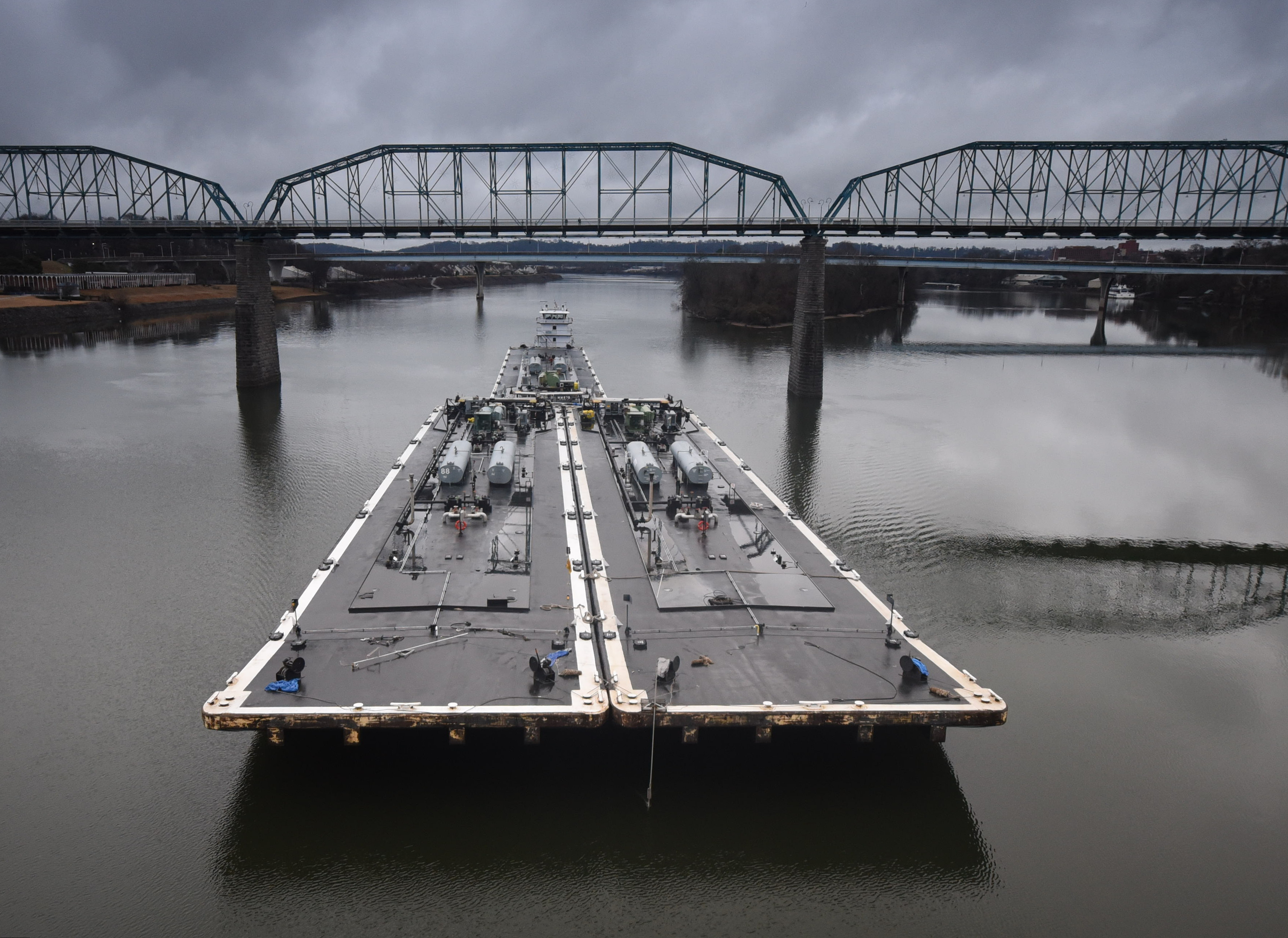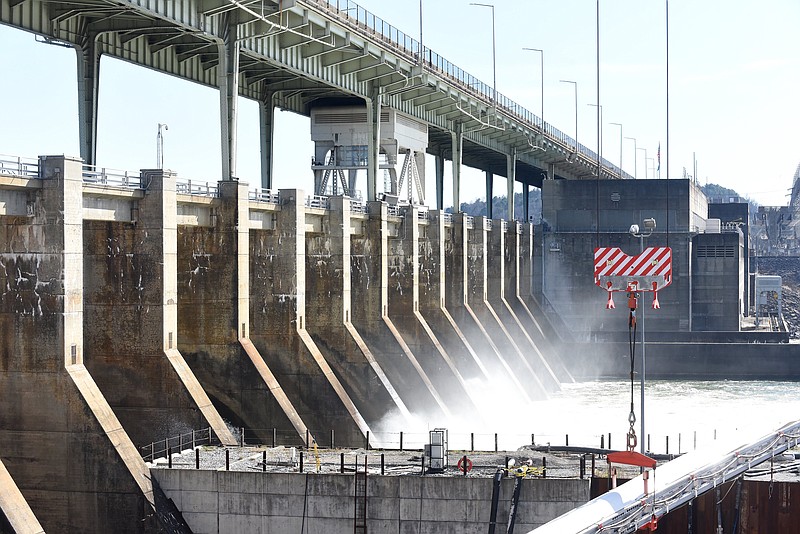In a typical year, the Tennessee Valley averages 52 inches of rain, or nearly 72% more than the U.S. average. But in the past three years, Mother Nature has dumped an average of more than 67.25 inches on rainfall a year in the Tennessee River region, or more than double the rest of the nation's average, according to the National Weather Service.
The extra precipitation hasn't hurt the sunny outlook for cities like Chattanooga, however. In fact, all that water - most of which drains through Chattanooga on the Tennessee River - provides plenty of liquidity for the local economy.
As the drainage route for 21,400 square miles of East Tennessee, Northeast Georgia and parts of Virginia, North Carolina and Kentucky, the Tennessee River carries a minimum of 8.5 billion gallons of water a day through Chattanooga and sometimes much more. All that water has been an economic lifeline for the Scenic City, providing drinking water, river recreation and scenery, hydroelectric power and barge transportation to meet the needs of both local residents and industry that has developed or been drawn to the Chattanooga area because of the river.
TVA reshapes the region with the river
The Tennessee Valley Authority, the nation's largest public power utility created in 1933 to harness the power of the Tennessee River, estimates its water management efforts generate $11.9 billion of annual economic impact along the 652-mile length of the Tennessee River, or more than $1 million per shoreline mile along the nation's fifth biggest river. A TVA-funded study of the Tennessee River by the University of Tennessee's Institute of Agriculture estimates that TVA's reservoirs support over 130,000 jobs in TVA's seven-state region.
"TVA's mission has been to improve the lives of the Valley and our integrated river management system is one of the cornerstones of our efforts," says Mike Skaggs, executive vice president of operations for TVA.
In addition to those recreational benefits, the river's navigation route for barges to ship agricultural products, raw materials and manufactured goods helps save more than $400 million a year in transportation costs. The 13 locks along the Tennessee River provide passage for more than 25,000 barges a year, each carrying up to 50 tons of goods along the water route. More than than 6,000 boats and recreational vessels also go through the river locks every year.
In Chattanooga, the aging 81-year-old Chickamauga Lock is being replaced with a new and bigger lock. The $757 million new lock chamber is scheduled to open by April 2024. Despite the nearly doubling of its costs from the original proposal nearly two decades ago, the new lock is projected to have an annual economic payback of $52.9 million in lower transportation costs.
TVA's 29 hydroelectric dams on the river also help supply more than 10% of the utility's electricity, valued at nearly $1 billion a year as TVA's cheapest energy supply. The pumped storage facility atop Raccoon Mountain just west of downtown Chattanooga is able to use Tennessee River water to act as a giant power storage facility to allow TVA to generate power when it is needed the most.
"Our hydro units were our original renewable, carbon-free source of power," TVA President Jeff Lyash says.
The river also has provided cooling water for the operation of TVA's major power plants, including all three of its nuclear power plants and most of TVA's coal-fired plants.
 Photography by Tim Barber / From the Market Street Bridge, a tug pushing a large covered barge passes beneath the Walnut Street Bridge in downtown Chattanooga. Every year, more than 25,000 tow barge shipments are made along the Tennessee River. Each barge keeps an average of 90 semi-tractor trailers off the highway.
Photography by Tim Barber / From the Market Street Bridge, a tug pushing a large covered barge passes beneath the Walnut Street Bridge in downtown Chattanooga. Every year, more than 25,000 tow barge shipments are made along the Tennessee River. Each barge keeps an average of 90 semi-tractor trailers off the highway.
Chattanooga stays above water
As the power headquarters for TVA and one of the most flood-prone major cities before TVA's creation, Chattanooga is among the biggest beneficiaries of the Tennessee River that flows through the city.
Chattanooga initially developed at Ross's Landing on what is now the downtown waterfront nearly two centuries ago. But prior to TVA building the Chickamauga Dam in 1940, the city often flooded during heavy springtime rains. Chattanooga was nearly completely underwater during major floods in 1917 and in the worst flood ever in 1867.
During an average year, TVA's reservoir operations avert approximately $300 million in flood damage. TVA estimates it has helped avoid nearly $9 billion in flood damage since it completed its first dam, Norris Dam, in 1936, and most of that avoided flood damage has been in the Chattanooga area.
TVA's network of 49 dams erected on the Tennessee River and its tributaries created reservoir lakes that have not only promoted lakefront recreation but storage reservoirs to limit flooding along the Tennessee River.
James Everett, senior manager of TVA's River Forecast Center, said the mountains that surround Chattanooga and the number of creeks and rivers flowing into the Tennessee River upstream of Chattanooga combine to create flooding challenges after heavy rains in the region.
"There's an enormous area that flows into the Tennessee River and goes through Chattanooga," Everett says. "We manage the river and its reservoirs to help with flood control as well as TVA's other objectives for maintaining water quality, river navigation, hydroelectric power and recreation and development."
The river has been a recruitment draw in Southeast Tennessee for a variety of industries that are able to ship either raw materials or major manufactured goods on the river, including such riverfront businesses as Resolute Forest Products (formerly Bowater), Olin Chlor Alkali Products in Charleston, and LJT Steel and Signal Mountain Cement in Chattanooga. The river was used in the past by the city's biggest manufacturers, including Combustion Engineering, Roper and Central Soya, before those operations shut down.
New life for reclaimed river
Through much of its history, the river has also been used as a dumping ground for municipal sewage. But clean water regulations imposed by the U.S. Environmental Protection Agency over the past half century are cleaning up most of the river's pollutants, including a $250 million agreement with EPA by the city of Chattanooga to improve its sewer and stormwater systems, and a similar pending consent decree being worked on by the Hamilton County Water and Wastewater Treatment Authority.
Across the Tennessee Valley, the Tennessee River supplies drinking water for more than 5 million users. Over 10 billion gallons of water are used daily from the river by 700 municipal and industrial intakes, but 96% of that water is recycled and returned to the river to be used again, according to TVA.
As the river has been cleaned up, many riverfront cities, including Chattanooga, have rediscovered the appeal of their waterfronts.
Nearly four decades ago, Chattanooga and Hamilton County established the Moccasin Bend Task Force to look at the future of Moccasin Bend and help gain national park status for the riverfront site. But the task force also ultimately came up with a blueprint for a 20-year, $750 million riverfront development and downtown revitalization known as the Tennessee River Park Master Plan,
The plan has helped spur such projects as the Tennessee Aquarium, Coolidge Park, Ross's Landing, Tennessee Riverwalk, The Passage, Renaissance Park and the restoration and expansion of the Walnut Street Bridge and the Hunter Museum of Art.
"We have rediscovered the river and it's been a home run for Chattanooga," says Rick Montague, the former president of the Lyndhurst Foundation who served on the Moccasin Bend Task Force in 1982. "At the time, Chattanooga was an industrial and unfortunately a very divided community. I think what the river and what the city has done over the years along the waterfront has helped to bring people from all walks of life together."
The Tennessee Riverwalk that will soon stretch from the Chickamauga Dam to St. Elmo in Chattanooga attracts residents and tourists alike, and the river has been a backdrop for such entertainment events as the Riverfront nights and the Riverbend Festival that have drawn thousands of people back to Chattanooga's river roots.
Bob Corker, the former U.S. Senator and Chattanooga mayor, championed the riverfront revival of Chattanooga and as mayor helped lead the $120 million 21st century waterfront plan that expanded the Tennessee Aquarium and Hunter Museum of Art and created a new riverfront walkway, park, boat dock and amphitheater.
Corker says when he first became mayor in 2001 the Aquarium was still separated from the river by a state highway along Riverfront Parkway. By altering the road makeup and control of the downtown streets and raising $120 million in city hotel taxes and private fundraising, Corker led an ambitious effort to revitalize the waterfront with both private and public spaces.
"This helped fully connect downtown with the river and made Chattanooga's riverfront a place to draw major events like the Head of the Hooch (rowing competition), the Ironman triathlon, music festivals and literally millions of visitors," Corker says. "Ross's Landing on the river was a trading post that gave birth to our city and I'm proud that we've reclaimed that history in a way that really showcases our city and its attractions to help boost both tourism and homegrown business."
READ MORE
* Return to the riverfront: Millions in new development and more activation planned for Chattanooga sites along the Tennessee River * Drawn to the water: Properties on the river and lakes go for a premium, and they're increasingly scarce * 'If there's an oceanfront view in Chattanooga, this is it' * A natural attraction: The Tennessee River draws a steady stream of visitors to the Scenic City
